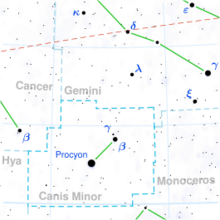Astronomy:Gamma Canis Minoris
| Observation data Equinox J2000.0]] (ICRS) | |
|---|---|
| Constellation | Canis Minor |
| Right ascension | 07h 28m 09.79333s[1] |
| Declination | +08° 55′ 31.9068″[1] |
| Apparent magnitude (V) | +4.33[2] (4.46 + 6.66)[2] |
| Characteristics | |
| Spectral type | K3 III Fe-0.5[3] (K4 III + K1: III)[2] |
| U−B color index | +1.53[4] |
| B−V color index | +1.43[4] |
| Astrometry | |
| Radial velocity (Rv) | 46.8±0.3[5] km/s |
| Proper motion (μ) | RA: −61.09[1] mas/yr Dec.: −10.70[1] mas/yr |
| Parallax (π) | 10.25 ± 0.47[1] mas |
| Distance | 320 ± 10 ly (98 ± 4 pc) |
| Absolute magnitude (MV) | −0.5±0.1[2] |
| Absolute magnitude (MV) | 1.7±0.2[2] |
| Orbit[2] | |
| Period (P) | 389.310 ± 0.012d |
| Semi-major axis (a) | 17 mas |
| Eccentricity (e) | 0.25856 ± 0.00039 |
| Inclination (i) | 66° |
| Periastron epoch (T) | 2449849.172 ± 0.089 HJD |
| Argument of periastron (ω) (secondary) | 142.079 ± 0.090° |
| Semi-amplitude (K1) (primary) | 21.243 ± 0.010 km/s |
| Semi-amplitude (K2) (secondary) | 21.526 ± 0.017 km/s |
| Details[2] | |
| γ CMi A | |
| Mass | 1.88 M☉ |
| Radius | 36.8±2.6 R☉ |
| Luminosity | 321±33 L☉ |
| Temperature | 4,036±100 K |
| Rotational velocity (v sin i) | 5±2 km/s |
| Age | 1.3 Gyr |
| γ CMi B | |
| Mass | 1.85 M☉ |
| Radius | 7.8±1.0 R☉ |
| Luminosity | 25.4±5.2 L☉ |
| Temperature | 4,658±200 K |
| Rotational velocity (v sin i) | 2.0±2.0 km/s |
| Other designations | |
| Database references | |
| SIMBAD | data |
Gamma Canis Minoris (γ Canis Minoris) is a binary star system in the equatorial constellation Canis Minor. Its orange colour is obvious when seen through binoculars.[7] The system is visible to the naked eye with a combined apparent visual magnitude of +4.33.[2] Based upon an annual parallax shift of 10.25 mas as seen from Earth,[1] this system is located about 320 light years from the Sun.
This spectroscopic binary star system has an orbital period of 389.31 days, a semimajor axis of 1.48 AU, and an eccentricity of 0.2586.[2] Their variable radial velocity was discovered by H. M. Reese in 1902 at Lick Observatory.[8] Both components are evolved, K-type giant stars, most likely on their first ascent along the red giant branch. The primary, component A, has a stellar classification of K4 III while the secondary, component B, may be K1: III.[2]
References
- ↑ 1.0 1.1 1.2 1.3 1.4 1.5 van Leeuwen, F. (2007), "Validation of the new Hipparcos reduction", Astronomy and Astrophysics 474 (2): 653–664, doi:10.1051/0004-6361:20078357, Bibcode: 2007A&A...474..653V.
- ↑ 2.0 2.1 2.2 2.3 2.4 2.5 2.6 2.7 2.8 2.9 Fekel, F. C. et al. (March 2013), "The spectroscopic orbit of the K-giant binary γ Canis Minoris", Astronomische Nachrichten 334 (3): 223, doi:10.1002/asna.201211842, Bibcode: 2013AN....334..223F.
- ↑ Keenan, Philip C.; McNeil, Raymond C. (1989), "The Perkins catalog of revised MK types for the cooler stars", Astrophysical Journal Supplement Series 71: 245, doi:10.1086/191373, Bibcode: 1989ApJS...71..245K.
- ↑ 4.0 4.1 Johnson, H. L. (1966), "UBVRIJKL Photometry of the Bright Stars", Communications of the Lunar and Planetary Laboratory 4: 99, Bibcode: 1966CoLPL...4...99J.
- ↑ de Bruijne, J. H. J.; Eilers, A.-C. (October 2012), "Radial velocities for the HIPPARCOS-Gaia Hundred-Thousand-Proper-Motion project", Astronomy & Astrophysics 546: 14, doi:10.1051/0004-6361/201219219, A61, Bibcode: 2012A&A...546A..61D.
- ↑ "gam CMi". SIMBAD. Centre de données astronomiques de Strasbourg. http://simbad.u-strasbg.fr/simbad/sim-basic?Ident=gam+CMi.
- ↑ Kambič, Bojan (2009). Viewing the Constellations with Binoculars: 250+ Wonderful Sky Objects to See and Explore. Springer. p. 32. ISBN 978-0387853543. https://books.google.com/books?id=3vxLNPNHOcwC&pg=PA233.
- ↑ Campbell, W. W. (September 1902), "Six stars whose velocities in the line of sight are variable", Astrophysical Journal 16: 114–117, doi:10.1086/140954, Bibcode: 1902ApJ....16..114C.
 |


